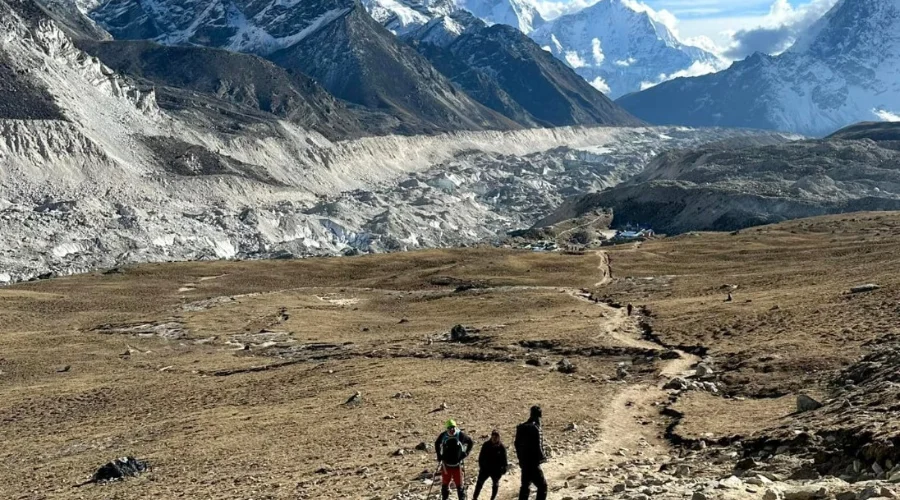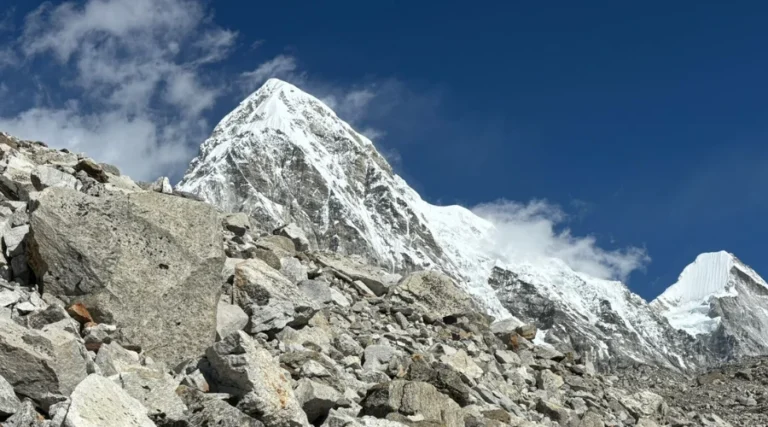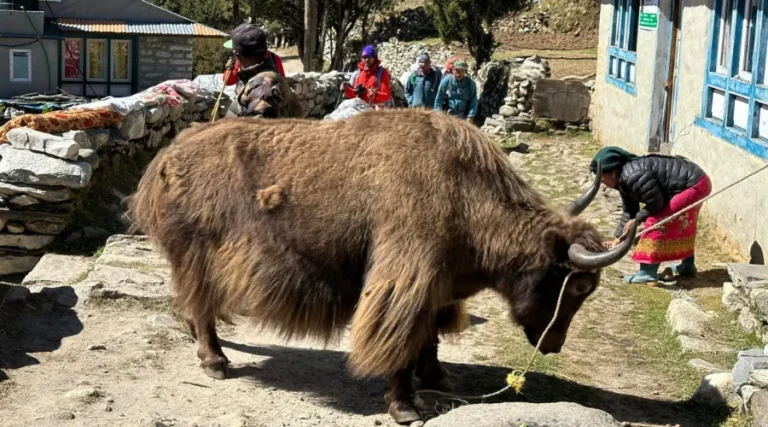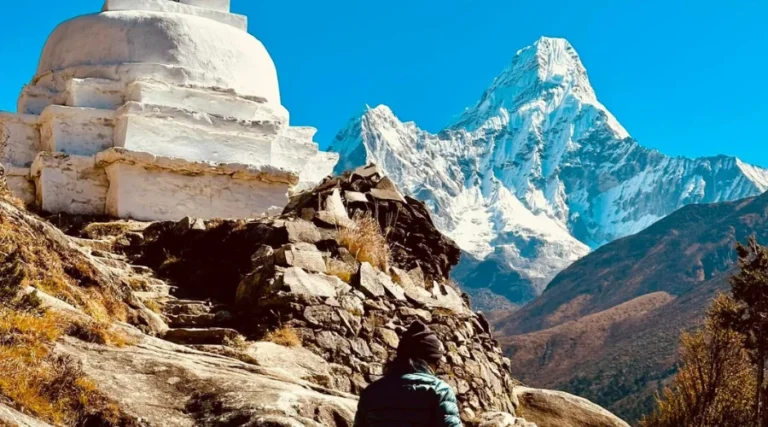Everest Base Camp Trek and Helicopter Return
-

Trip Duration 11 Days
-

Max, Altitude 5545 Meters
-

Type Luxury
-

Best Season Sept - May
-

Meals Included
-

Accommodation Guest House
-

Activity Heli Trek
-

Difficulty Strenuous
- Breathtaking panorama of the Himalayas with views from all directions of Mount Everest, Lhotse, Makalu and other peaks.
- Travel to traditional Sherpa villages, e.g., Namche Bazaar and Tengboche.
- Reach the world-famous Everest Base Camp, a big success for the trekkers.
- Visit the historic Tengboche Monastery, one of the most ancient and magnificent regions.
- Skip the long trail by enjoying some of the best scenes from a helicopter ride back to Kathmandu.
- See the awe-inspiring bird’s-eye-view of Everest and other mountains.
- Acclimatize as appropriate in Namche and Dingboche to lower altitude sickness risk.
- Immerse in the local Sherpa culture, traditions, and hospitality
- It is faster to complete the trek due to the helicopter landing.
The Everest Base Camp Trek and Helicopter Return is an excellent yet comfortable trekking package that provides the best experience of the Himalayas. From Lukla, trekkers will ascend gradually through the Sherpa settlement, green meadows, and beautiful forests.
Everest Base Camp Trek and Helicopter Return Overview
On the Everest Base Camp Trek, you’ll see famous places such as Namche Bazaar, the Tenboche Monastery, and the Dingboche, as well as magical views of the highest mountains on earth: Everest, Lhotse, Makalu, and the neighbouring mountains of the Himalayas.
During the trek, you arrive at Everest Base Camp, a truly spectacular location at the base of the earth’s tallest peak. At base Camp, you can enjoy the beautiful scenery, celebrate making it here, and chill out before heading home. Instead of trekking down, you’ll board a helicopter for the return flight.
The helicopter ride provides a fantastic aerial panorama of the mountains and regions, giving visitors a unique perspective of the area. This brief and picturesque route saves several days of walking and allows visitors to reach Kathmandu safely.
The Everest Heli Return Trek’s total difficulty and ease of return make it accessible to people who wish to see the Everest area but do not have the chance to do a long return trek.
Everest Base Camp with Helicopter Return is ideal for travellers who want to experience the thrill and beauty of the mountains without demanding hiking conditions.
The Everest Base Camp Trek and Helicopter Return are suitable for those who want less strenuous trekking, are short on time, or want to admire the majesty of the Himalayas from the air.
With this opportunity, you will spend your trip having unforgettable experiences and saving time.
Why Choose the Everest Base Camp Trek and Helicopter Return Option?
This trek is especially suitable for those who want to reach Everest Base Camp but don’t want a longer return trek.
The trek provides beautiful panoramic views of the Himalayan Mountains through the Sherpa ethnic majority territories and remarkable sites like Tengboche Monastery. You’ll also experience the thrill of reaching Everest Base Camp, an unforgettable achievement.
The main advantage of this option is the helicopter return. After arriving at Base Camp, you’ll be flown back by helicopter instead of walking, saving time and effort.
The ride provides unparalleled aerial exposure to Everest and all the surrounding peaks.
What to Expect During the Everest Base Camp Trek and Helicopter Return
The Everest Base Camp Trek will lead you to breathtaking Sherpa villages, deep forests, high-altitude scenery, and stunning views of Mount Everest, Lhotse, and other peaks.
Upon reaching Base Camp, you will enjoy not only the personal satisfaction that comes with success but also the stunning scenery.
You won’t walk back; instead, you’ll be lifted off in a helicopter for a fast and breathtaking flight back to Kathmandu. The helicopter ride provides an incredible aerial view from above the hills and their surroundings.
Throughout the journey, you’ll encounter challenging yet rewarding moments, and the combination of trekking and the Everest helicopter ride makes it easier and more comfortable.
Get ready for incredible imagery, extraordinary cultural experiences and a different way of looking at Everest.

Short Itinerary
Itinerary of Everest Base Camp Trek and Helicopter Return
You will be welcomed at the airport by our representative who will escort you to your hotel. A welcome dinner will be organized for your arrival in Nepal. Overnight in Kathmandu
We start early for a thrilling flight to Lukla. We meet the rest of the team there and then head down towards the Cheplung village. There you will get your first glimpses of the sacred Mt. Khumbila. We then continue onwards Phakding. Overnight in Phakding.
After a nice breakfast, we head on a trail that passes through a pine forest. We then move northwards through the Benkar valley. After crossing the Dudh Koshi River, we pass the villages of Chumoa and Monjountil we reach the entrance of the Everest National Park.
Then we climb a steep trail to finally reach Namche Bazaar. Overnight in Namche Bazaar.
We have reserved this day for the purpose of acclimatization. It is important to properly adjust our bodies to the high altitude. On this day, we will explore Namche. Namche is the biggest town in the region filled with shops, restaurants, internet cafes and a brilliant market.
Moreover, we can also go for a short climb on the Sagarmatha National Park to watch the sun rise over the colossal mountains of Mt. Everest, Lhotse, Nuptse, Ama Dablam, Thamserku, Kongde and many more. In addition, we can also explore the ancient Khumjung village.
The village is home to the Hillary School and a monastery which claims to have a Yeti Scalp on display. Overnight in Namche Bazaar.
With breakfast done, we move down towards the Dudh-Koshi River enjoying views of Mount Everest, Lhotse, Nuptse, AmaDablam, Thamserku, and Kongde. We then climb up through rhododendron forests to Tengboche.
There we visit the largest monastery in the entire region – The Tengboche Monastery-the largest monastery in the region. Overnight in Tengboche.
We head down towards Debuche passing through forests of birch, conifers, and rhododendrons. Furthermore, we get to enjoy magnificent views of Mt. Everest, Lhotse, and AmaDablam. After that, we cross the Imja River and head towards Pangboche.
The trail towards upper Pangboche is filled with extraordinary views of the Himalayas and the Pangboche Monastery. We then walk towards Imja Valley andLobuche River. From there, we start our ascent towardsDingboche. Overnight at Dingboche.
On this day, we go for a hike to either Nagarjun Hill or Chukkhung Valley. En route, we will witness the beauty of the Lhotse, Chalotse, Tawache and AmaDablam.We will also explore the Dingboche Village. The village is home to beautiful fields of barley, buckwheat and potatoes protected by stone walls.
Firstly, we steadily climb towards Duglha at the end of the terminal moraine of the Khumbu Glacier. We then ascent a steep trail to Chupki Lhara. There we can see the memorials for Scott Fischer (American mountaineer) and ten time Everest conquerer- Babu Chiri Sherpa (Nepali mountain guide) marked by an array of stones with prayer flags.
Both perished on a mission to climb Everest, the memorial is a grim reminder of the dangers of climbing the highest mountain in the world.
After this, we continue onwards the Khumbu Glacier moraine. There we are greeted by extraordinary views of the Khumbutse, Lingtren, Pumori and MahalangurHimal. We then gradually head towardsLobuche. Overnight in Lobuche.
We move through the sandy Gorakshep, which once used to be a lake bed. We continue on passing through a rocky terrain, moraine and streams to finally reach the Everest Base Camp. We spend time absorbing the beautiful views of Nuptse, Khumbuste and Pumorifrom the base camp.
The base camp itself is decorated with colorful prayer flags and colorful tents. With that done, we head back to GorakShep for rest and sleep. Overnight in GorakShep.
We start before dawn for our journey today. We soon start seeing the Khumbutse, and Changtse towards the east. We also start getting glimpses of Everest. We get the most amazing panoramic views of Everest once we reach Kalapatthar (5,545m/18,192ft).
We then head back down to Gorakshep. From there we take a helicopter ride back to Kathmandu via Lukla with be flying over the holy and pristine Gokyo Lake. A farewell dinner will be organized for celebrating your successful trip. Overnight in Kathmandu.
So, it is time to say farewell. This is your last day in Nepal. Our representative will escort you to the airport for your flight back home.
Lukla Flight Information
The weather conditions in the mountain region of Nepal can change rapidly and aviation schedules are not as reliable as you might expect. The flight between Ramechhap/Manthali and Lukla is frequently delayed and maybe cancelled for the day or several days in succession. In the event your flight is cancelled we will either rebook your flight for the following day. It is recommended to apportion one or two extra days in case your flight gets cancelled and you are in short of scheduled time.
Price includes
- Kathmandu Airport – Hotel – Airport transfer by Private vehicle
- Three Meals (Breakfast, Lunch and Dinner) during the trek
- Tea and Coffee during the trek
- Twin Sharing Accommodation at Kathmandu at 3 star hotel with breakfast
- Twin sharing accommodation during the trek
- National Park Entry Fee, Local Government Entry fee
- Domestic Flight from Kathmandu/Ramechhap to Lukla
- Helicopter ride from Gorakshep to Kathmandu
- 1 Experienced guide for the group of 2 to 10 and assistant guide for a group above 10
- One porter assigned for two people to carry luggage
- Our Staff’s daily meal, wage, equipment, insurance and allowances
- First aid kit with high-altitude medicines
- Duffel bag and Sleeping bag (Must be returned after completion of the trek)
- Trek completion certificate (Upon request)
- Our Service Charges
Price Excludes
- International airfare, Nepal Visa and travel insurance
- Meals in Kathmandu except breakfast
- Extra night accommodation in Kathmandu ( early arrival or flight cancellation etc)
- Personal expenses such as shopping, Laundry, Internet, Phone call etc
- Drinking water, cold drinks and alcohol drinks
- Gratuities for staff
Have any Questions? Check out FAQ'S
Trip Essential Information
Best Time for Everest Base Camp Trek and Helicopter Return
The best times for Everest Base Camp Trek and Helicopter Return are spring (March to May) and autumn (September to November).
During these seasons, the sky is clear, the temperature is moderate, and the weather is calm, making the trek comfortable and safe. The trail is full of rhododendrons during this season. Autumn offers cool air and a blue Himalayan sky, perfect for trekking.
Winter (December through February) is unbearably cold, and severe snowfall can make the trail challenging, particularly at elevation.
Summer (June to August) is the monsoon season, and with the precipitation and its resulting landslide risk, trekking can be hazardous and challenging.
Plan your trek in spring or fall to get the best experience. The weather is appropriate for both trekking and helicopter return, so it is a good time to experience the grandeur of Everest without any possibility of bad weather.
How to Prepare Physically for the Everest Base Camp Trek and Helicopter Return
Endurance, strength, and stamina training will be conducted to prepare physically for the Everest Base Camp Trek and helicopter return.
Start by hiking on different terrains for at least 3-4 weeks. Over time, increase the length and challenge of your hikes to carry out 4-6 hour treks.
To increase stamina, incorporate aerobic training (e.g., running, cycling, or swimming). Ideally, cardio should be 30-60 minutes three to four times weekly.
Strengthen your core and upper body with exercises like squats, lunges, push-ups, and planks to support your posture and reduce fatigue during the trek.
Altitude training may be helpful, but it is not always necessary. Climb to higher altitudes wherever possible to acclimatize to thin air. Otherwise, it improves cardiovascular and leg fitness to adapt to altitude.
Rest days should be part of your training so your body can recover. Stretch regularly to improve flexibility and prevent injuries.
Finally, practice walking with a backpack to get used to carrying your gear. Physical training will make it easier to navigate adventure trails and helicopter trips.
Accommodation Options on the Everest Base Camp Trek and Helicopter Return Route
Accommodation on the Everest Base Camp Trek and Helicopter Return route is mostly in teahouses, which are tiny, basic houses that offer food and lodging for a short stay.
In the hills, especially Lukla and Namche Bazaar, teahouses will be private, with private rooms and hot showers.
The teahouses at the base camp are less luxurious. They share the same space and provide a limited menu of services. Common restroom facilities and limited heating are available at higher altitudes, like Dingboche and Gorakshep.
The rooms are straightforward, with a bed, bedding, and a small table. Some teahouses offer Wi-Fi and charging facilities for a fee, but the coverage can be patchy.
Meals are served in a communal dining space. The menu includes food commonly eaten in Nepal (dal bhat) and international items. Though the facilities are small, they are surprisingly comfortable to rest on while hiking.
Safety Considerations for the Everest Base Camp Helicopter Return
Safety is one of the significant areas of attention on the Everest Base Camp Trek and Heli Return. The primary concern is altitude sickness, given that the hike is high and at high altitudes.
Acclimatization requires sufficient rest days and fluid intake. Altitude sickness may present as headache, dizziness, and vomiting, so please adequately monitor your symptoms.
Please pay attention to the weather, as it can change quickly. Trekking in spring or autumn provides the safest conditions. Do not trek alone without a guide; stay on the proper hiking path.
Do not fly the helicopter roundtrip with a less experienced company. Weather conditions can influence flight schedules, so flexibility is key. Proper equipment use, including warm clothing, strong footwear, and a first aid pack, is also crucial.
Cost for Everest Base Camp Trek with Helicopter Return
The Everest Base Camp Trek with Helicopter Return are unforgettable adventures. The total cost of this package ranges between USD 1500 and USD 3000 per person.
This price includes essential services such as trekker permits, hotels, food, and the rescue helicopter flight from Everest Base camp to Kathmandu. The trek is provided with professional guides, porters, and all necessary transportation and will allow a stress-relieved journey.
Accommodation is available in tea houses along the way, and the package includes food, including local and international dishes.
Helicopters for the return flight to Base Camp are an easy, scenic, and relaxed alternative route out of Kathmandu and also avoid the long descent back.
Drinks, snacks, and souvenir purchases are not included in the package. However, we are transparent about pricing. The price may vary according to the service and the number of people you choose. We strive to offer the best value for your Everest experience.
How the Helicopter Return Enhances Your Everest Base Camp Trek Experience?
The helicopter trip is an added benefit to the trek to Everest Base Camp because it makes getting back to Kathmandu an even easier and more efficient option.
After the gruelling trek to Everest Base Camp, there is no need to trek back down to Lukla. It is possible to fly in a helicopter and enjoy the flight beautifully on the return journey, saving time and exertion.
The aerial scenery of Everest and its neighbouring peaks is spectacular on helicopter flights. You get a unique perspective of the Himalayas that you would never have on foot.
The flight is an experience that is hard to forget, along with the magnificent beauty of the land, admiring the beautiful valleys, glaciers, and peaks.
This is a good choice for people who do not have much time available in terms of waiting or for people who want to avoid the physical effort to go down by descending.
The ease and convenience of helicopter return make it an excellent choice for trekkers who prefer to devote their attention only to getting to Base Camp and the landscape, not to the complications of descent.
Returning by helicopter guarantees safety, as it avoids the danger of altitude sickness or tiredness, which may be present in a long hike. It also lets you finish the trek in style, making the trip to Everest Base Camp and back even more special and fun.
Booking the Everest Base Camp Trek with Helicopter Return Package
Himalayan Trekking and Tours provide Everest Base Camp Trek and Helicopter Return package for USD 2,150 per person. With this package, you are ready for an unforgettable adventure.
You’ll get permits, professional guides, porters, accommodation, meals, and a scenic helicopter ride back to Kathmandu from Everest Base Camp.
Our package is designed to comfort and protect you during your hike. You’ll trek through stunning landscapes, visit traditional Sherpa villages, and experience breathtaking views of Mount Everest and other peaks.
Since you’ll already be travelling from Base Camp, helicopter transport back to Kathmandu will reduce time and effort.
Booking with us is easy. Contact our team to reserve your spot. We maintain price transparency, and we have no hidden fees.
We’re committed to making your Everest Base Camp experience as memorable and smooth as possible. Come along on this fantastic adventure and create memories that last forever!
Travel Insurance for Everest Base Camp Trek And Helicopter Return
The Everest Base Camp Trek and Helicopter Return require travel insurance. Flying back to Kathmandu by helicopter is subject to field conditions and can be affected by bad parameters such as weather conditions.
Flights may be delayed or even cancelled. Insurance covers this, so you are protected if your flight is rescheduled, delayed, or even cancelled.
Insurance also covers medical expenses related to emergencies and evacuations, especially at altitude. When trekking in the mountains, one may get altitude sickness or be injured; insurance provides for this.
Insurance also includes trip cancellation and interruption, which is crucial due to the unpredictability of helicopter returns.
As mentioned earlier, selecting a policy that covers trekking at high altitudes, helicopter evacuation, and medical bills is essential.
Travel insurance means you can be safe, knowing that any emergency or complications that occur while you are on a trek will be financially manageable.
Common Challenges During the Everest Base Camp Trek and Helicopter Return
Altitude Sickness:
Altitude sickness is one of the most experienced problems in the Everest Base Camp Trek. But air becomes scarce and thinner as you go up in the highlands.
The symptoms of altitude sickness include headaches, shortness of breath, dizziness, nausea, and loss of appetite. The risk of altitude sickness can be reduced by having regular rest days and enough water.
Weather Conditions:
Conditions in the Everest region are hardly predictable. During the day, it can snow or rain.
These conditions can make trekking difficult and, at times, unpredictable. Because of the bad weather, you must dress appropriately, bring the necessary equipment, and be ready to change your plans.
Physical Demands:
Reaching the Everest base camp through the region requires physical health. Climbing a long distance consistently on a higher terrain is very tiring.
Trekking in steep terrain is expected throughout the trek to the base, which may take 6-8 hours daily. This may considerably drain energy, especially if the terrain is steep or rocky.
Limited Facilities at Higher Altitudes:
The amenities will be pretty simple as we trek higher. At the teahouses, one gets very simple rooms and some of the rooms share toilets, there might be times that there is no hot water or heating.
These limits can be a hardship for those accustomed to comfortable accommodations.
Flight Delays and Cancellations:
When using the helicopter return to shorten the trek, the weather and other factors, like helicopter traffic, can hinder access to the location.
As with any form of aviation, helicopter flights can be affected by bad weather, meaning travellers should be ready for flexibility when they are on the flight.
Frequently Asked Questions (FAQ)
Everest Base Camp Trek with Heli Return is a trek to Everest Base Camp with a helicopter ride back to Kathmandu, saving time and energy.
The Everest Base Camp Trek and Helicopter Return cost around USD 2,150 per person.
The package includes permits, accommodation, meals, guide services, and the helicopter ride back to Kathmandu.
A professional guide is essential for safety, navigation, and local knowledge.
The trek is moderate to challenging, requiring good physical fitness, especially at higher altitudes.
Yes, with preparation and reasonable fitness, beginners can do the trek with the help of a guide.
Proper acclimatization, staying hydrated, and taking rest days will help reduce the risk of altitude sickness.
Accommodation will be in basic teahouses with shared rooms, especially at higher altitudes.
Charging is available in most teahouses, but there may be a fee and limited availability at higher altitudes.
Yes, travel insurance is highly recommended for coverage of medical emergencies, altitude sickness, and flight delays.
- Instant Confirmation
- Free to customize
- Support anytime
© 2025 - Himalayan Trekking and Tours (P) Ltd. All Rights Reserved.













